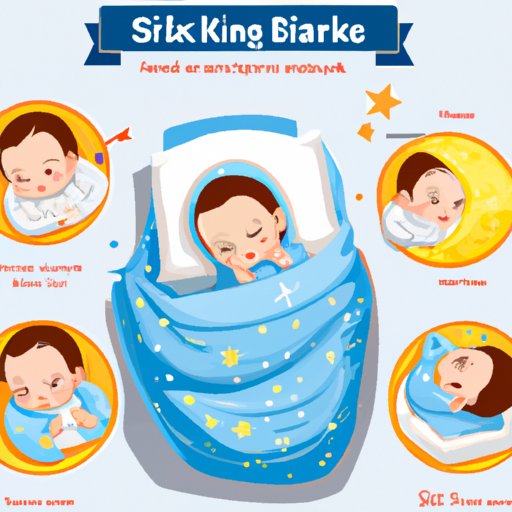
Introduction
Swaddling is a practice that has been around for a long time. It has been used by parents to calm a crying baby and help them sleep soundly. Swaddling involves wrapping babies with a blanket, snugly and securely, creating a warm, womb-like environment. While swaddling can have its benefits, many parents wonder how long to swaddle their babies. In this article, we will explore the benefits and risks of swaddling, the appropriate age to stop, and how to transition your baby to sleep without a swaddle.
Pros and Cons of Swaddling: Understanding the Right Time to Stop
Swaddling can have various benefits for newborns. It can help them sleep better, reduce their crying, and prevent sudden infant death syndrome (SIDS). However, swaddling can also have some drawbacks. If done improperly, it can result in developmental dysplasia of the hip, a condition where the hip joint fails to develop properly. Swaddling can also result in overheating, which can increase the risk of SIDS.
It is essential to know when to stop swaddling your baby. Some babies may outgrow swaddling at three months, while others may continue until they are six months old or more. Factors to consider in determining the right time to stop swaddling include the baby’s age, development, and preference.
Swaddling: Is There a Limit to This Soothing Technique?
It is essential to stop swaddling your baby as they grow older because it can be restrictive and limit their movement. For instance, swaddling can prevent them from crawling, sitting, and rolling over. It can also interfere with their motor and social development, including bonding with their parents and caregivers.
When your baby can roll over, it is recommended to stop swaddling them immediately to prevent the risk of suffocation. The appropriate age to stop swaddling is usually between three to six months, depending on your baby’s developmental milestones and preferences.
To Swaddle or Not to Swaddle: The Debate and Duration Discussed
Despite the benefits of swaddling, some experts argue that it can have long-term negative effects. For instance, swaddling for too long can cause problems with breastfeeding and reduce the time your baby spends in an active and alert state, which can affect their cognitive development. Some experts also suggest that swaddling can hinder the development of the baby’s respiratory system.
While the debate around swaddling continues, there are some general guidelines that parents can follow. It is recommended to swaddle your baby for the first three to four months and then gradually transition them to sleeping without a swaddle.
Understanding Your Baby’s Sleep Needs: How Long Should You Swaddle?
The length of time your baby should be swaddled can vary depending on their age, developmental stage, and sleep needs. For instance, if your baby has difficulty sleeping without swaddling, you may need to continue until they are ready to sleep without it. However, if your baby shows signs of being ready to transition, you can start reducing the duration and loosen the swaddle gradually.
You should also look out for signs that your baby is no longer interested in swaddling. These signs may include breaking free from the swaddle, resisting the swaddle, or moving around too much while swaddled. These signs may indicate that your baby is ready to sleep without a swaddle.
Swaddling and Safe Sleep: Tips for Parents on When to Stop Swaddling
It is essential to ensure that your baby is sleeping safely while swaddled. You should always place your baby on their back to sleep and avoid loose blankets, pillows, and other items that may cover their face or cause them to overheat. Always ensure that the swaddle is snug but not too tight, and check your baby’s temperature regularly to prevent overheating or hypothermia.
The American Academy of Pediatrics recommends that parents stop swaddling once their baby shows signs of being able to roll over. Rolling over increases the risk of suffocation, and swaddling increases the risk further by limiting the baby’s movement and ability to escape if they get into a dangerous position.
Gradual Unswaddling: A Guide to Transitioning Your Baby to Sleep Without a Swaddle
If you have concluded that it is time to stop swaddling your baby and transition them to sleeping without it, you can do so gradually. This process involves gradually loosening the swaddle and eventually eliminating it altogether.
Start by swaddling your baby with one arm out for a few nights before removing the swaddle completely. Observe how your baby responds and adjust accordingly. It may take a few days to a few weeks to transition your baby to sleeping without a swaddle, but with patience and consistency, you can create a safe and comfortable sleep environment for your baby.
Conclusion
In conclusion, swaddling can have its benefits and drawbacks, and it is essential to determine the right duration for your baby. While pediatricians recommend swaddling for the first few months, it is important to watch for signs of readiness to stop swaddling and gradually transition your baby to sleeping without it. With careful observation and guidance, parents can create a safe, nurturing, and comfortable sleeping environment for their newborns.




